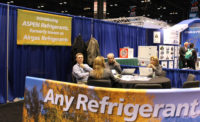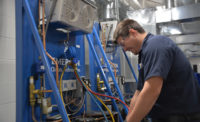While geothermal heat pumps may initially seem complicated to service or troubleshoot for some technicians, with the right training, they will find that these systems are similar to conventional air-source heat pumps. That’s the word from Josh McClendon, water-source heat pump product support, Trane, an Ingersoll Rand brand.
“The maintenance required for geothermal systems is fairly straightforward and includes regular replacement of air filters, cleaning the condensate drain pan, checking the loop water pressure, and occasionally cleaning the heat exchanger coils,” McClendon said.
He offered six actions for a technician to take when servicing or troubleshooting a geothermal system.
1. Check the air filter and air coil for cleanliness, since a dirty filter and/or air coil will affect airflow and refrigerant pressures;
2. Verify that the unit is receiving electrical supply power and that control voltage is present;
3. Check the control board diagnostics (if applicable);
4. Verify there is a call from the thermostat or control system;
5. Verify there is water pressure in the loop; and
6. Verify the loop pumps are running, and there is water flowing through the heat exchanger.
Additionally, McClendon said much can be learned about unit performance by checking the heat of extraction (water-side capacity heating) and heat of rejection (water-side capacity cooling). The equation for heat of extraction is:
Heat of extraction (Btuh) = Flow (gpm) x delta T (T in - T out) x Fluid Factor*
(*The fluid factor is used in calculating heat of extraction/rejection. The fluid factor of water is 500, antifreeze is typically 485.)
This calculation should then be compared to the manufacturer’s published performance data.
“This is a great method for determining if the equipment is performing correctly,” he said.
McClendon added that the most common issues he has encountered in malfunctioning geothermal units are standard maintenance items, such as condensate overflow, switch trips, failure of the blower motor or compressor, and low airflow or refrigerant.
A few other common issues that are specific to geothermal units are low or no water flow and the condenser loop fluid being outside the designed operating temperature range.
“Two common indicators of low water flow are reduced capacity and the unit not keeping up with the set point,” McClendon explained. “If the water flow is too low, it can trip the high- or low-pressure freezestat switches. One action that can assist with diagnosing low water flow is to take a water temperature and pressure differential reading between the entering water and leaving water. The manufacturer’s performance data will be needed to verify that the equipment is in the proper operating range. There are a few factors to consider, but it could be caused by a restricted strainer or an improperly functioning or improperly sized loop pump.”
In addition, the temperature of the loop is important. One indication that the loop temperature is out of range is reduced capacity or a tripped safety switch.
“Start by checking the entering water temperature,” McClendon said. “If the loop temperature is not within the proper operating range, this may be the problem. This could be caused by the loop being undersized or improperly designed.”
Finally, McClendon noted that geothermal units will not function if there is a bad circulating pump in the system. In commercial applications with multiple units operating on the same loop, all of the units will shut down due to unit safeties and fail to operate. Pump failure can be caused by electrical failure or malfunctioning controls.
KEEPING IT SIMPLE
Danny Christian, commercial service manager, Comfortworks, Goldsby, Oklahoma, said commercial geothermal systems are generally very easy to maintain, but there are two crucial steps service technicians must keep in mind. The first is to always check the water pressure and ensure it’s not low, which could indicate a leak.
“That’s No. 1, because, obviously, if you’re out of water, none of the units will work,” Christian said.
The second important step is to check the pressure drop across the system’s basket strainer.
“We usually have a basket strainer to catch any type of debris in the water, and it’s important to check the pressure drop across that strainer to see if the system needs to be shut down and the filter pulled out and cleaned,” he said. “Those are the two main maintenance tasks: You change the filters and make sure you have water to the unit. That’s about all you have to do to them.”
Christian added that scaling is typically not an issue with geothermal systems.
“Most of our systems use polyethylene pipe, so we don’t have to use chemicals,” he said. “If we use anything, it will be a glycol antifreeze that will contain rust- or growth-inhibitors. But, generally, we don’t have any issues with scaling in geo systems.”
START WITH PROPER DESIGN
When it comes to troubleshooting commercial geothermal systems, it’s important to ensure that the system was properly designed to begin with, said Steve DiBerardine, president, Strategic Energy Solutions Inc. (SES), a consulting engineering and geothermal contracting company in Berkley, Michigan.
According to DiBerardine, there’s only one way to design a commercial system: by performing a detailed annual energy analysis that takes into account all 8,760 hours of the year — not just the hottest and coldest hours.
“You need to use software that can give you a complete annual energy analysis, because you need to know how much energy is being transferred to and from the earth on an annual basis,” he said. ”I suspect there are still people out there who use rule-of-thumb or back-of-napkin calculations. Those projects will either be overdesigned and waste the owner’s money, or they may fail and do a real disservice to a building owner.”
By way of example, DiBerardine said SES was called in to troubleshoot a system in which the loop water coming into the building was running hot. It shot past the desired 90°F set point and climbed to nearly 100°.
“We had to figure out what was making this system run hot and causing equipment to shut down on safeties,” he said.
SES ran an energy analysis to see if the ground loop had been designed properly and also ran sequences of operation on the system’s geothermal heat pumps. They found that the loop was too short, and the heat pumps and valves were improperly sequenced. Heat pumps generating domestic hot water were bleeding hot water into the chilled water loop and essentially fighting each other. SES was able to salvage the system and keep it running, but the situation was preventable with proper design, installation, and commissioning.
Of course, a good design won’t guarantee a trouble-free system when human error is involved. SES was called in to troubleshoot a large, seven-year-old horizontal loop system in a high school, which was having numerous flow problems. They found that an electrical contractor had bored into the geothermal piping while installing a light pole.
“They patched it up but didn’t go back to properly flush it to purge any dirt, debris, or air out of the system” DiBerardine said. “That led to mud being drawn into and clogging every strainer in the system. That school had five years of headaches because the break in the system wasn’t properly addressed when it happened.”
In terms of routine service and maintenance, DiBerardine said he favors distributed heat pump systems over central plant systems. He said installing multiple 2- to 5-ton heat pumps with each heat pump serving a zone leads to the lowest possible maintenance costs.
“We have a distributed heat pump system in our building, and in the nine years we’ve been here, all we’ve done is change the air filters,” he said.
The challenge with a distributed system is doing a life cycle cost analysis and trying to determine when the building owner will need to start replacing the heat pumps.
“I don’t think anybody knows or could agree on the life span of a 3-ton water-to-air heat pump,” DiBerardine said. “I’ve heard people say they’ve run 20-plus years with no trouble, and other people say they’ve had them last for seven years. So, from a life cycle cost analysis, it can be hard to determine.”
Publication date: 10/9/2017











